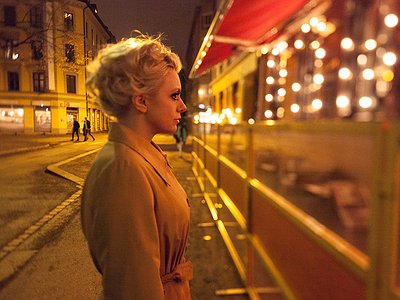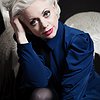Name: Hilde Luise Asbjørnsen
Nationality: Norwegian
Occupation: Singer, Songwriter
Current Release: Red Lips, Nuckles and Bones on Ozella
Recommendations: I think you should know about Hariton Pushwagners work. I especially find «Soft City» to be a powerful and important piece that represents his work and his criticism of our time and age.
I would also like to recommend the most recent solo album of Anders Aarum; «Shakin’ Our Souls», that just came out on Ozella Music. He has released three earlier albums with his trio, and kept his fans waiting for 13 years for this last one. I find it wonderfully groovy, hypnotising and adventurous.
If you liked this interview with Hilde Louise Asbjørnsen, you'll enjoy her website, which features more information, current updates and music.
When did you start writing/producing music - and what or who were your early passions and influences? What what is about music and/or sound that drew you to it?
I started writing songs and lyrics when I was around 15 and I took lessons with a piano teacher who taught me playing by chords. Up until then I had only played classical music by notes from the age of 8.
This new way of playing freed my fantasy. After that I wrote little songs now and then, as a way of putting down thoughts and expressing myself. I never dreamt about playing them to an audience until years later.
Music was a big part of growing up in Sykkylven. I sang in the choir, my family sang a lot, and music was all around us as a joyful part of everyday life. I listened to everything contemporary, but I think my mother's vinyls of Edith Piaf live and her jazz records of Louis Armstrong, Dave Brubeck and Ella Fitzgerald influenced me more than I was aware of back then. When I got a «disc man», the first CD I bought was a Verve Collection of Sarah Vaughan.
For most artists, originality is first preceded by a phase of learning and, often, emulating others. What was this like for you? How would you describe your own development as an artist and the transition towards your own voice? What is the the relationship between copying, learning and your own creativity?
I did not start singing jazz before I started writing my own songs and performing them, so the process of learning vocal technique and finding my own sound has been a parallel process along with developing as a composer. When I formed my first band, I included some jazz standards into my repertoire along with my own music. These songs were my ideals back then; Lush Life, Night and Day, Darn That Dream, etc. I think I tried to write songs that sounded like Cole Porter and the Tin Pan Alley writers. A lot has happened since then, but I hope my voice will always be in development, along with my way of writing songs. I feel that with every album I am coming a little bit closer to my true self, exploring my own potential and the potential in the chemistry within the band.
Along with aiming for the most heartfelt expression for a specific album, I believe and hope that this development will continue as long as I sing and create music.
What were your main compositional- and production-challenges in the beginning and how have they changed over time?
When I recorded my first album I had hardly been in a recording studio before. But I had a very clear plan for the arrangements, the tempi, the instrumentation, and even wrote the voicing for the cello, so I felt that I was in control of the process anyway. Through the years I have learned a lot, working close with my pianist, who also has produced and co-produced 4 of my albums; Anders Aarum. But my involvement in this part of the process has varied from album to album.
On my previous release, «Don’t Stay For Breakfast» (Grappa, 2015), I engaged a producer from outside the band, Georg Wadenius, and I let him take a lot of decisions, also in the mix. The rehearsals and the recording was a collective process within the band, and I felt a relief in letting go and not being involved all the way. But on this album, «Red Lips, Knuckles and Bones» (Ozella Music), I’ve had a different motivation. I composed some of the music together with Anders, but I was more active in arranging and pointing out grooves and instrumentation to the band than earlier. I did a lot of the vocals alone in the studio, searching for the right approach and editing them myself.
I learn something through every kind of process, and I think the recipe for the changes continuously, depending on the type music I’ve written and my ambitions with it.
What was your first studio like? How and for what reasons has your set-up evolved over the years and what are currently some of the most important pieces of gear for you?
I wrote my first 5-6 albums, and a few cabarets, on an old, white Petrof piano that I inherited from my aunts. For «Sound Your Horn» (Sweet Morning Music, 2008), I had discovered Protools, and used a Yamaha digital piano and an SM58 to make sketches on the songs with a separate baseline and vocal arrangements at home. That was a lot of fun. But the last years I have come back to writing on my new Petrof piano, that sounds better than the last, and perhaps leaning more on the process with my band. I really adore the playing style of every single member of Hilde Louise Orchestra. We have a special communication, we share a love for the same artists and expressions, and we really enjoy working together. Right now, people are my most important gear.
How do you make use of technology? In terms of the feedback mechanism between technology and creativity, what do humans excel at, what do machines excel at?
I don’t use much technology when making music. We might use some samples, e.g. of the Mellotron, and we have been experimenting with different reverbs and some plug-ins in the mixing process, but that is about it. We make acoustic music. I used to sing with a Swedish band called KOOP, and they used some pre-produced music in concerts, and based many of their songs on samples from old jazz records, combining them with electronic music and a live band. Those dynamics were exciting to work with, it was like pop music with the old jazz sound, and it reached a larger audience in terms of being more danceable. Some of my songs have been remixed into the «soulful house» genre by the music producers KEW & R. Richards, and I can hear that the melodies and the vocals live a different life in these pre produced, mechanical sounds. They are more lonesome, but then also more in focus.
Production tools, from instruments to complex software environments, contribute to the compositional process. How does this manifest itself in your work? Can you describe the co-authorship between yourself and your tools?
Along with my state of mind and my skills, I find that the sound of the instrument I am playing on influence the directions I take with the melodies. Writing on the acoustic piano compared to a Rhodes can make me chose differently because they put me in very different moods. The Rhodes is warm, soothing and intimate, I might tend to write more floating and airy music working on the Rhodes.The piano is more direct and passionate. I wrote a few songs on the ukulele too, and that brings out something completely different. More bluesy and groove based.
Collaborations can take on many forms. What role do they play in your approach and what are your preferred ways of engaging with other creatives through, for example, file sharing, jamming or just talking about ideas?
As mentioned above, the people I work with are very important to me. They are my friends, and because they have worked with my music, they know me in a different way. Making music is a personal process to me. We often try to discuss the different approaches to our music, but we always end up playing it out. We share files and introduce each other to new artists and expressions, and that is a great inspiration. But the most exciting part is always to hear what it sounds like when some of us tr to copy it, because it always comes out different than the original. It has been very interesting writing melodies and placing my lyrics into Anders Aarum harmonies, because he has a different approach that makes me chose differently when it comes to the melodies and the words.



